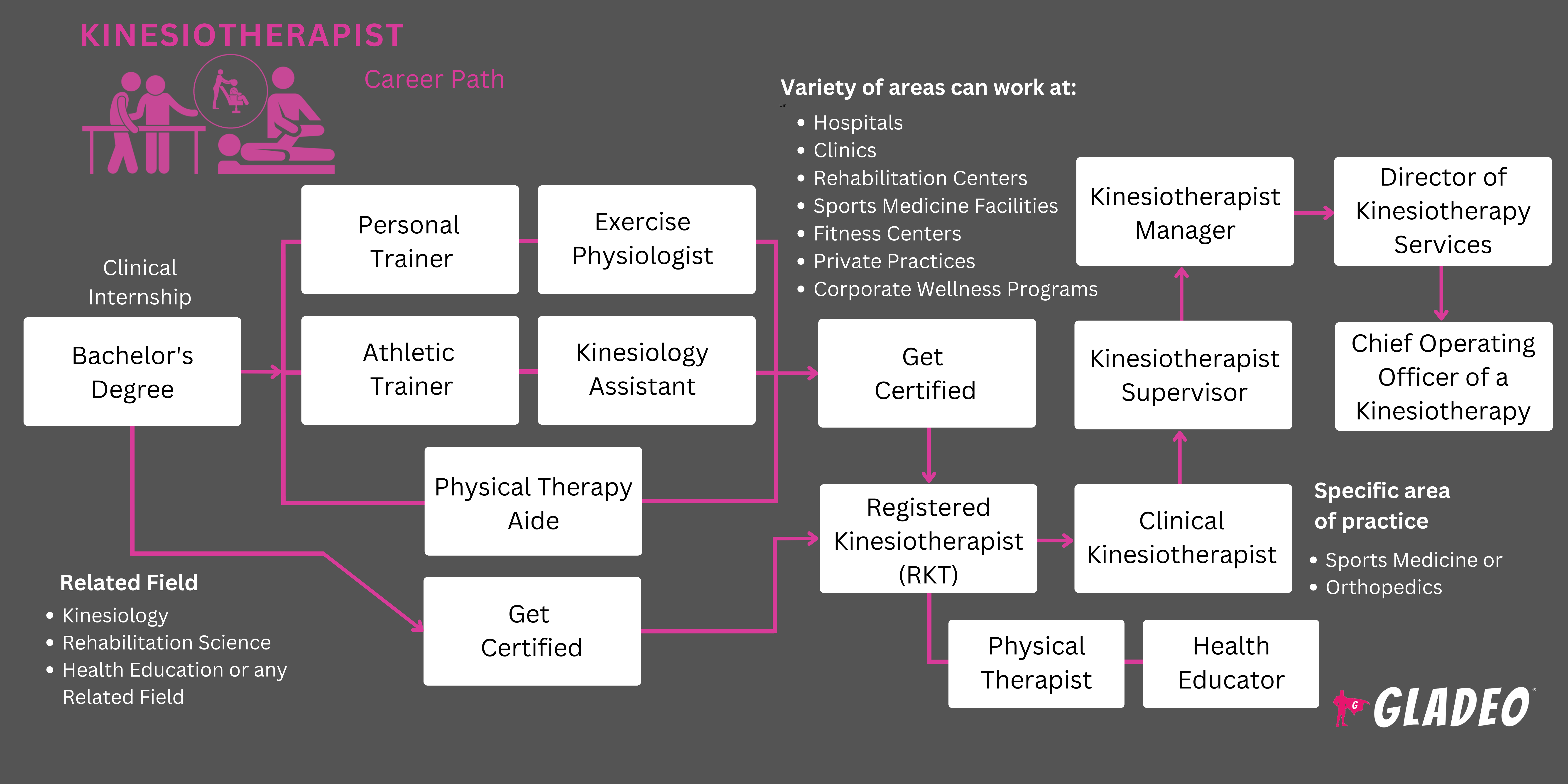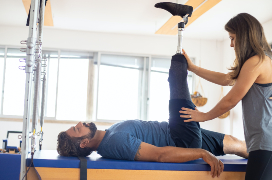Spotlights
Vật lý trị liệu (PT), Nhà trị liệu nghề nghiệp (OT), Nhà trị liệu phục hồi chức năng, Nhà sinh lý học tập thể dục, Nhà trị liệu thể thao, Huấn luyện viên thể thao, Nhà trị liệu giải trí, Nhà trị liệu khiêu vũ / vận động, Huấn luyện viên cá nhân, Chuyên gia phục hồi chức năng tim
Kinesiotherapists use exercise and movement science to help people recover from certain injuries or manage conditions that affect physical performance. They design personalized rehabilitation programs that rebuild strength, flexibility, and functional mobility.
They’re considered a type of exercise physiologist, focusing on rehabilitation, reconditioning, and physical education to help people get back lost strength and boost their endurance. Their patients may include athletes recovering from sports injuries and individuals managing chronic illnesses like arthritis.
- Helping patients regain their mobility and independence
- Making a significant impact on the quality of life of their patients
- Collaborating with other healthcare professionals to provide comprehensive care
- Staying engaged with cutting-edge exercise science and rehabilitation techniques
Lịch làm việc
- Kinesiotherapists typically work full-time office hours. Some travel in order to meet patients.
Nhiệm vụ tiêu biểu
- Review patients’ pertinent medical history, including X-rays, CT scans, MRIs, and ultrasounds
- Observe the physical signs of patient conditions and discuss their symptoms
- Take baseline measurements via active, passive, and active-assisted range of motion assessments
- Evaluate mobility limitations and joint function issues. Assess pain and discomfort causes and levels
- Develop customized programs to increase mobility, strength, and endurance
- Collaborate with physicians, physical therapists, other healthcare providers, and family members, as needed
- Demonstrate exercises. Monitor and correct patients when it is their turn to do them
- Establish goals and caution patients on injury prevention
- Take routine measurements to gauge the effectiveness of exercises
- Monitor and document patient progress. Make adjustments as needed
Trách nhiệm bổ sung
- Provide motivational support and encouragement
- Stay current with advancements in exercise science and rehabilitation practices
- Ensure exercise equipment is properly maintained
Kỹ năng mềm
- Phân tích
- Chú ý đến chi tiết
- Truyền thông
- Phối hợp
- Quyết định
- Cảm
- Kỹ năng giao tiếp giữa các cá nhân
- Kỹ năng tạo động lực
- Kỹ năng tổ chức
- Giải quyết vấn đề
- Quản lý thời gian
Kỹ năng kỹ thuật
- Strong understanding of anatomy, physiology, and kinesiology
- Knowledge of therapeutic exercise techniques and modalities
- Proficiency in assessing patient physical abilities and limitations
- Ability to adapt exercise programs to accommodate various medical conditions
- Ability to use diagnostic tools and equipment
- Understanding of chronic disease management
- Familiarity with electronic health records (EHR) systems
- Trung tâm thể dục
- Bệnh viện
- Long-term care facilities
- Hành nghề tư nhân
- Trung tâm phục hồi chức năng
- Sports medicine clinics
Kinesiotherapists often work closely with patients who are in pain or facing physical limitations, so their job requires empathy and patience. They must be in good shape in order to accurately demonstrate exercises and assist patients with movements. In addition, there’s a need for continuous learning to maintain proficiency and currency when it comes to skills and industry knowledge.
Kinesiotherapists are increasingly using technology to enhance patient care. This includes virtual rehabilitation programs, wearable fitness trackers, and telehealth consultations. There is also a growing emphasis on preventative care and wellness programs to reduce the incidence of chronic diseases and improve overall population health.
Kinesiotherapists likely enjoyed sports, physical activities, and helping others when they were younger. They may have had a natural curiosity about how the human body works and a passion for fitness and health!
- Kinesiotherapists typically need a bachelor’s degree in kinesiology, kinesiology, exercise science, or a related field
- Per O*Net, 32% hold a master’s degree and 9% have a doctoral degree
- Programs should be accredited by the Commission on Accreditation of Allied Health Education Programs
- Relevant college course topics include:
- Biomechanics
- Chronic disease management
- Exercise physiology
- Giải phẫu người và sinh lý học
- Động học
- Motor skills control
- Sự dinh dưỡng
- Tâm lý học
- Rehabilitation neurology
- Thống kê
- Therapeutic exercise science
- Students should also complete Basic Life Support or Advanced Cardiovascular Life Support certification
- Kinesiotherapists participate in clinical internships to gain practical experience under supervision. After graduating, those who have successfully completed 1,000 hours of clinical practicum can register with the American Kinesiotherapy Association
- Note, registration may not be required, but it demonstrates competency to potential employers
- Practitioners can seek specialized certifications from organizations such as the American College of Sports Medicine or the American Kinesiotherapy Association to broaden their knowledge. For example, they may specialize in areas such as:
- Amputee Specialist
- Cardiac Rehabilitation Specialist
- Drivers Rehabilitation Specialist
- Driver Rehabilitation Professional Microcredential
- Fall Prevention Specialist
- Functional Capacity Evaluation Specialist
- Geriatrics Specialist
- Health Coach Specialist
- Orthopedic Specialist
- Senior Home Safety Specialist
- Research Specialist
- Tai Chi Specialist
- Weight Management Specialist
- Whole Health Specialist
- There are a range of related apprenticeship opportunities to consider
- Look for accredited institutions offering programs in kinesiology, kinesiology, or exercise science
- Seek programs that feature plenty of hands-on training opportunities via clinical practicums. Some courses can be taken online, but many require practical in-person experience
- Check out the faculty biographies to learn about their expertise in the field
- Review the job placement rates for graduates
- So sánh chi phí học phí và lệ phí, lưu ý chi phí trong tiểu bang so với ngoài tiểu bang
- Review scholarship and financial aid options. If applying for federal aid Pell Grants, make sure the money can be used to pay the tuition at your particular school of interest
- Veterans can seek military-friendly schools with on-site VA benefit experts
- High school classes in biology, chemistry, and physics are useful
- Playing sports and engaging in regular exercise are beneficial because they offer first-hand knowledge of kinesiology principles related to human movement and the impact of physical activities on the body
- Gain practical experience through part-time jobs, volunteer work, or apprenticeships
- Become a personal trainer and offer your services either freelance or at a local gym
- Keep up with industry trends related to new technologies such as wearable health monitors
- Watch YouTube videos about kinesiotherapy and physical therapy
- Read articles and journals such as ACSM’s Health & Fitness
- Participate in relevant student clubs in college to make friends, stay motivated, and network
- Kết nối với các chuyên gia trong lĩnh vực này và tìm kiếm cơ hội cố vấn

- To land a job as a Kinesiotherapist, you’ll need to finish your education and training, including any required clinical practice hours
- Ask people in your professional network for tips about job openings. Request recommendation letters from previous supervisors or professors. Get their permission before giving out their contact information
- Review job ads on sites like Indeed, Monster, and Glassdoor
- Review resume templates. Highlight relevant skills in your resume, using keywords from job ads such as:
- Chronic disease management
- Exercise prescription
- Patient assessment
- Progress monitoring
- Rehabilitation techniques
- Check out Kinesiotherapist resume templates
- Prepare for interviews by researching common Kinesiotherapist interview questions such as:
- “When you first meet with a client, how do you go about assessing their needs?”
- “If a patient came in complaining of back pain, what evaluations would you perform?”
- Run through some mock interviews with friends or your school’s career center
- Ăn mặc chuyên nghiệp khi phỏng vấn xin việc
- Consider applying to an apprenticeship program
- Let your supervisor know you’re interested in advancing your career
- Take advanced courses or complete specialized certifications such as Amputee Specialist or Drivers Rehabilitation Specialist
- Consider earning a higher-level degree, such as a master’s or doctorate. Think about becoming a physical therapist – or a medical doctor if you really want to boost your earnings!
- Use downtime to learn about new technologies and best practices
- Establish solid professional working relationships with peers and other healthcare providers
- Train and mentor new Kinesiotherapists and assistants
- Provide outstanding customer service to patients to ensure positive outcomes
- Stress safety at all times so that patients do not overextend themselves and exacerbate injuries
- Be an active participant in professional organizations such as the American Kinesiotherapy Association
- Consider relocating if necessary to move up. Some states have more job openings than others!
Các trang web
- American Academy of Physical Medicine and Rehabilitation
- American Association of Cardiovascular and Pulmonary Rehabilitation
- Đại học Y học Thể thao Hoa Kỳ
- Hội đồng Thể dục Hoa Kỳ
- Hiệp hội Kinesiotherapy Hoa Kỳ
- Hiệp hội Vật lý trị liệu Hoa Kỳ
- American Physiological Society
- American Society of Exercise Physiologists
- Hiệp hội Điền kinh và Thể hình Hoa Kỳ
- Clinical Exercise Physiology Association
- Ủy ban Công nhận các Chương trình Giáo dục Sức khỏe Đồng minh
- Committee on Accreditation for the Exercise Sciences
- Hiệp hội Sức khỏe và Thể hình IDEA
- Học viện Y học Thể thao Quốc gia
- National Athletic Trainers Association
- Hiệp hội Sức mạnh và Điều hòa Quốc gia
- Society of Health and Physical Educators
- The Physiological Society
- World Heart Federation
Sách vở
- Clinical Kinesiology and Anatomy, by Lynn S. Lippert PT MS
- Kinesiology: The Skeletal System and Muscle Function, by Joseph E. Muscolino
- Kinesiology Taping for Rehab and Injury Prevention: An Easy, At-Home Guide for Overcoming Common Strains, Pains and Conditions, by Aliana Kim
- The Muscle and Bone Palpation Manual with Trigger Points, Referral Patterns and Stretching, by Joseph E. Muscolino D
Kinesiotherapists are vital members of the healthcare community. Their work helps keep patients mobile so they can enjoy a better quality of life. If this isn’t exactly the career you’re looking for, but you want to explore similar options, check out our list below for some alternative ideas!
- Huấn luyện viên thể thao
- Nhà sinh lý học tập thể dục
- Fitness Trainer
- Health Coach
- Quản lý dịch vụ y tế và sức khỏe
- Nhà trị liệu nghề nghiệp
- Nhà vật lý trị liệu
- Trợ lý vật lý trị liệu
- Rehabilitation Specialist
- Bác sĩ Y học Thể thao
Nguồn cấp tin tức

Công việc nổi bật

Các khóa học và công cụ trực tuyến

Kỳ vọng mức lương hàng năm
New workers start around $81K. Median pay is $99K per year. Highly experienced workers can earn around $113K.






